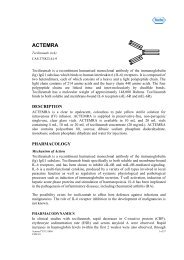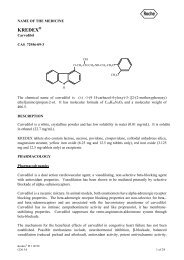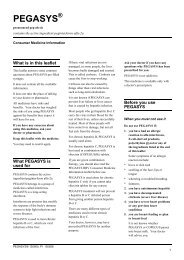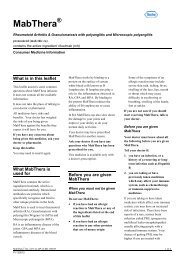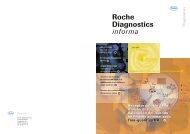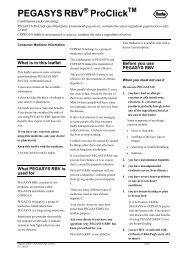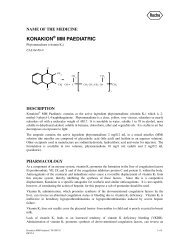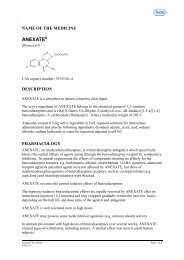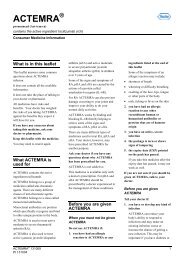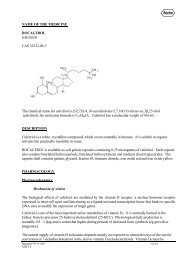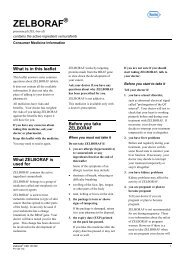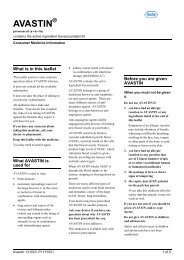Product Information PI - Roche Australia
Product Information PI - Roche Australia
Product Information PI - Roche Australia
Create successful ePaper yourself
Turn your PDF publications into a flip-book with our unique Google optimized e-Paper software.
available capsule formulations were selected on the basis to provide oseltamivir carboxylate<br />
exposures considered safe and efficacious in clinical trials.<br />
Refer to DOSAGE AND ADMINISTRATION for recommended dosing for patients with<br />
severe, moderate and mild renal impairment.<br />
Two clinical studies were performed to evaluate the pharmacokinetic, safety and tolerability<br />
of oseltamivir and oseltamivir carboxylate in end stage renal disease patients undergoing<br />
haemodialysis (HD) and continuous ambulatory peritoneal dialysis (CAPD). In study<br />
PP15974 patients undergoing either CAPD or HD received a single 75 mg capsule of<br />
oseltamivir, whereas in study NP16472 patients received 30 mg oseltamivir oral suspension<br />
for 6.5 weeks, with CAPD patients receiving a single dose per week and HD patients a dose<br />
after alternate dialysis sessions. In order to assist in determining appropriate dosing<br />
recommendations in HD, a population pharmacokinetic model for HD was constructed and<br />
qualified for simulation. Suitable regimens using available capsule formulations were<br />
selected on their basis to achieve oseltamivir carboxylate plasma trough levels in subjects<br />
with normal renal function dosed at 75 mg twice daily for treatment, or 75 mg oseltamivir<br />
given orally once daily for prophylaxis.<br />
Refer to DOSAGE AND ADMINISTRATION for recommended dosing for patients with end<br />
stage renal disease undergoing haemodialysis and continuous ambulatory peritoneal dialysis.<br />
Hepatic impairment<br />
Based on in vitro and animal studies, significant increases in exposure to oseltamivir or its<br />
metabolite are not expected and this has been confirmed in clinical studies in patients with<br />
mild or moderate hepatic impairment. The pharmacokinetics of a single oral dose of<br />
oseltamivir 75 mg have been established in moderately hepatic impaired (Child-Pugh score 7<br />
– 9) patients. Results of the study showed that C max and AUC of active metabolite of<br />
oseltamivir in the 12 hepatic impaired patients fell within the therapeutic margin of safety and<br />
efficacy. The safety and pharmacokinetics in patients with severe hepatic impairment have<br />
not been studied (see DOSAGE AND ADMINISTRATION).<br />
Elderly<br />
Exposure to the active metabolite at steady-state was approximately 25% higher in elderly<br />
patients (age range 65 – 78 years old) compared to young adults given comparable doses of<br />
TAMIFLU. Half-lives observed in elderly patients were similar to those seen in young adults.<br />
On the basis of drug exposure and tolerability, dosage adjustments are not required for elderly<br />
patients for either treatment or prophylaxis of influenza unless there is co-existent renal<br />
impairment (see PRECAUTIONS and DOSAGE AND ADMINISTRATION).<br />
Paediatrics ≥ 1 year of age<br />
The pharmacokinetics of TAMIFLU have been evaluated in pharmacokinetic studies in<br />
children aged 1 – 16 years old. Multiple dose pharmacokinetics were studied in a small<br />
number of children aged 3 – 12 years old enrolled in a clinical trial. The rate of clearance of<br />
the active metabolite, corrected for bodyweight, was faster in younger children, than in adults,<br />
resulting in lower exposure in these children for a given mg/kg dose. Doses of 2 mg/kg and<br />
Tamiflu <strong>PI</strong> 6 mg/mL oral suspension and capsules 120119 5 of 28<br />
CDS 10.0



